
Tunisia’s National Circular Waste Management Strategy 2035-2050 was recently presented to Maghreb journalists from Tunisia, Algeria, and Morocco during a regional workshop organized in Tunis by the “Afrique 21” Network.
The strategy was introduced by environmental advisor, lawyer, and member of the National Forum for Climate Change Adaptation in Tunisia (FNACC), Sondes Fnaiech, as part of a presentation on the « Tunisian Circular Economy Landscape. » The strategy, based on circular economy principles, is considered an essential step to address climate change and includes three sectorial components: plastic management, composting from household and similar waste, and the recycling of rubble and demolition waste.
For plastics, three main objectives have been established. These include reducing the consumption and production of plastic items, enabling a circular economy for plastic production to protect the environment and human health, and ensuring the rational ecological management and recycling of plastic waste.
Non-biodegradable plastics are a major source of environmental pollution with long-term impacts on human health, soil, and marine environments. In Tunisia, 4.2 billion plastic bags are used annually. According to a World Bank (WB) report, the country generates 2.8 million tons of household waste annually, of which 9.4% are plastic waste.
Tunisia’s plastics industry consists of at least 283 companies, with 79 of them being fully export-oriented. The annual volume of poorly managed plastic waste is estimated at 55.5 thousand tons, according to the same WB report. Furthermore, plastic pollution poses a significant threat to Tunisia’s blue economy, with the country incurring losses from plastic pollution estimated between 170 and 561 million dollars per year, according to the « Plastic-Free Coast Strategy and Operational Action Plan Tunisia 2035 » report.
Widespread Negligence
Despite regulatory initiatives (such as the January 16, 2020 decree) and government projects like Eco-Lef, Tunisia’s first packaging waste management system aimed at reducing pollution, the recycling sector still suffers from disorganization and the lack of a clear regulatory framework. This was highlighted by participants in the regional workshop on « Circular Economy and Climate Change in the Maghreb. »
Most initiatives face obstacles like unfair competition from the informal sector and the lack of incentives for companies that follow regulations. As a result, most plastic waste ends up in landfills or in nature, exacerbating the environmental crisis.
According to environmental advisor Sondes Fnaiech, the national public waste management system generally aims to reduce landfilling and limit the environmental impact of waste. However, it lacks an effective public awareness strategy, which she warns could prevent initiatives from achieving their full potential.
“Education and awareness are crucial to promote responsible and informed consumption behaviors,” she argues, acknowledging that regulatory barriers and bureaucracy hinder the real advancement of the circular economy in Tunisia.
“Doomed Prophecies”
According to UNCTAD, if the global population reaches 9.8 billion by 2050, the equivalent of nearly three planets will be needed to provide the essential natural resources to sustain current lifestyles.
This underscores the necessity, according to the UN expert, to reduce plastic production at its source, a challenging task for a lucrative industry. In 2021, 369 million tons of plastics were traded, valued at 1.2 trillion dollars, a 30% increase from 2020.
UNCTAD advocates for identifying a range of biodegradable alternatives or substitutes (made from plants, fibers, cotton, algae, etc.) to plastic products and materials or for enhancing circularity and recycling, as plastics are traded globally, but waste remains due to the lack of recycling capacity.
On a global scale, if the current trend in global plastic production continues, greenhouse gas emissions from plastic production between 2015 and 2050 will exceed 56 billion tons, equivalent to 10 to 13% of global emissions.
However, transitioning to a circular plastic economy model, incorporating approaches like eco-design, reduction, reuse, and recycling throughout the product lifecycle, could significantly reduce GHG emissions, improve resource management, and stimulate innovation while creating new direct and indirect jobs.


